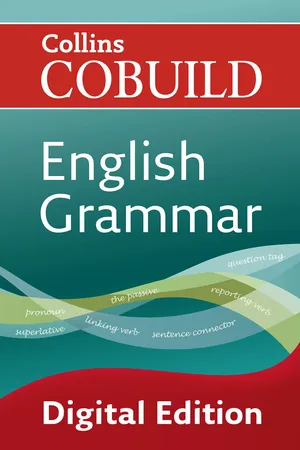About this book
This major new edition of the Collins COBUILD English Grammar is a modern, global and learner-focussed grammar reference, aimed at learners and teachers of English.
Thoroughly updated, to take into account significant changes in grammar over recent years, the Collins COBUILD English Grammar is based on the evidence of the 4 billion-word Collins corpus, and is an invaluable guide to the English language as it is written and spoken today, in all areas of the world.
With a user-friendly style and simple explanations, the Collins COBUILD English Grammar provides a comprehensive and authoritative guide to modern English grammar, using grammar terms that learners will understand.
Notes on the various situations in which certain grammar points typically appear, new examples, and information on the key differences between British and American grammar, make the Collins COBUILD English Grammar is the only fully-updated and truly global English grammar available.
Frequently asked questions
- Essential is ideal for learners and professionals who enjoy exploring a wide range of subjects. Access the Essential Library with 800,000+ trusted titles and best-sellers across business, personal growth, and the humanities. Includes unlimited reading time and Standard Read Aloud voice.
- Complete: Perfect for advanced learners and researchers needing full, unrestricted access. Unlock 1.4M+ books across hundreds of subjects, including academic and specialized titles. The Complete Plan also includes advanced features like Premium Read Aloud and Research Assistant.
Please note we cannot support devices running on iOS 13 and Android 7 or earlier. Learn more about using the app.
Information
1 Referring to people and things:
nouns, pronouns, and determiners
Introduction to the noun phrase
position
I couldn’t feel anger against him.
They were teachers.
Let us work together in peace.
common nouns and proper nouns
I went to Drexel University and then I went to Pittsburgh to work for a psychiatrist.
We flew to Geneva with British Airways.
determiners with common nouns
Have you got any comment to make about that?
There are some diseases that are clearly inherited.
…the destruction of their city.
She came in to see me this morning.
personal and demonstrative pronouns
‘Could I speak to Sue, please?’–‘I’m sorry, she doesn’t work here now.’
Some people have servants to cook for them.
This led to widespread criticism.
indefinite pronouns
In this country nobody trusts anyone.
A moment later, his heart seemed to stop as he sensed the sudden movement of someone behind him.
adding extra information
Table of contents
- Cover
- Title Page
- About Cobuild
- Introduction
- How to use this Grammar
- Glossary of grammatical terms
- 1 Referring to People and Things
- 2 Giving Information About People and Things
- 3 Types of Verb
- 4 Expressing Time: Tenses and Time Adverbials
- 5 Modals, Negatives, and Ways of Forming Sentences
- 6 Expressing Manner and Place
- 7 Reporting what People Say or Think
- 8 Combining Messages
- 9 Changing the Focus in a Sentence
- 10 Making a Text hold Together
- Reference Section
- The Grammar of Business English
- The Grammar of Academic English
- Index
- Copyright
